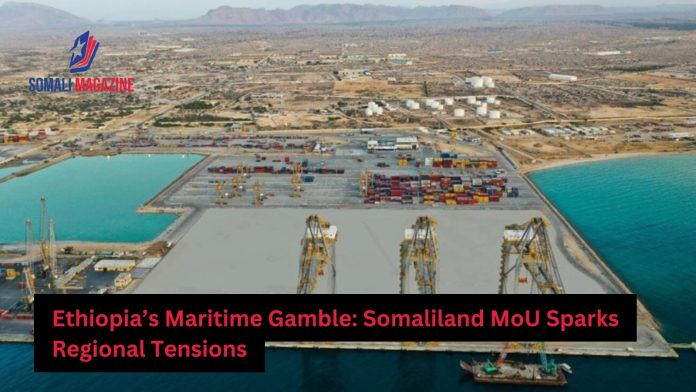Facebook Twitter Instagram Somali Magazine - People's Magazine
Ethiopia’s recent Memorandum of Understanding (MoU) with Somaliland has ignited a wave of diplomatic controversy, raising concerns about its potential to destabilize the Horn of Africa. Signed in January 2024, the agreement grants Ethiopia access to 20 kilometers of Somaliland’s coastline, a move that has drawn sharp criticism from Somalia and other regional stakeholders. While the deal aims to bolster Ethiopia’s maritime ambitions, it risks undermining regional stability and escalating tensions in an already volatile area.
The MoU, which includes provisions for Ethiopia to develop naval capabilities and utilize Somaliland’s ports, has been hailed by Addis Ababa as a strategic step toward diversifying its trade routes. As a landlocked nation, Ethiopia has long relied on Djibouti for over 90% of its maritime trade. The agreement with Somaliland offers an alternative, potentially reducing Ethiopia’s dependency on Djibouti and enhancing its economic resilience.
However, the deal has been met with fierce opposition from Somalia, which views Somaliland as an integral part of its territory. Somali President Hassan Sheikh Mohamud has condemned the MoU as a violation of Somalia’s sovereignty, likening Ethiopia’s actions to an affront on par with the threats posed by Al-Shabaab. In response, Somalia has launched a diplomatic campaign to rally international support against the agreement, further straining relations between the two nations.
The controversy surrounding the MoU extends beyond Somalia and Ethiopia. Regional players, including Kenya and Eritrea, have expressed concerns about the potential for the deal to disrupt the fragile balance of power in the Horn of Africa. The involvement of external actors, such as Egypt and Turkey, has added another layer of complexity to the situation. Egypt’s recent security agreement with Somalia, which includes the delivery of military hardware, is widely seen as a countermeasure to Ethiopia’s growing naval ambitions. Similarly, Turkey’s renewed defense partnership with Somalia underscores the geopolitical stakes at play.

Critics argue that Ethiopia’s MoU with Somaliland could set a dangerous precedent, encouraging other nations to bypass Somalia’s federal government in pursuit of bilateral agreements with Somaliland. Such actions risk further fragmenting Somalia and undermining efforts to achieve national unity. The deal has also fueled tensions within Somaliland, where opposition groups have accused the government of compromising the region’s autonomy for short-term economic gains.
The MoU’s implications for regional stability are significant. The Horn of Africa is already grappling with a host of challenges, including armed conflicts, humanitarian crises, and climate change. The addition of maritime disputes to this volatile mix could exacerbate existing tensions and hinder efforts to promote peace and development.
Ethiopia’s maritime ambitions, while understandable, must be balanced against the need for regional cooperation and respect for sovereignty. Analysts have called for greater transparency and dialogue to address the concerns raised by the MoU. They emphasize the importance of involving all relevant stakeholders, including Somalia’s federal government, in discussions about the region’s maritime future.
The international community has a critical role to play in mediating the dispute and fostering a collaborative approach to maritime development in the Horn of Africa. Organizations such as the African Union and the Intergovernmental Authority on Development (IGAD) are well-positioned to facilitate dialogue and ensure that agreements align with regional stability goals.
As Ethiopia and Somaliland move forward with the MoU, the stakes could not be higher. The agreement represents both an opportunity and a risk—a chance to enhance economic connectivity, but also a potential flashpoint for conflict. Navigating this delicate balance will require diplomacy, compromise, and a shared commitment to the greater good of the region.

